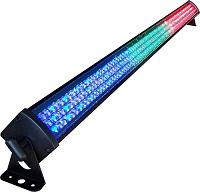This article discusses a simple circuit to adjust the high-brightness LED drive current, the circuit uses non-customized, highly integrated step-down switching regulator (MAX5035), the ability to accurately control the flow of LED current. 6.5V to 76V wide input voltage range, the MAX5035 DC / DC converter to maintain a fixed frequency of 125kHz, and is the ideal choice for automotive applications. The brightness control analog (linear regulator) or low duty cycle (PWM) to achieve.
The high brightness LED lights development background

In recent years, high-brightness LED (HB LED) as light sources in a variety of lighting systems increasingly favored, which is due to the high brightness LED with a high degree of reliability, service life can reach dozens or even tens of thousands of hours, than the traditional incandescent the life of the lamp or halogen several orders of magnitude higher. Based on this advantage, high-brightness LEDs in automotive lighting, public marked with the widely used signal signs and architectural lighting.
The high brightness LED is specially treated PN junction semiconductor devices, the forward bias may issue a white, red, green or blue (may also have other colors of light). Show as a PN junction VI characteristics similar to conventional diode, but with higher junction voltage drop. The forward voltage of VF blue LED (red LED 2.5V to 4.5V), the flow through the LED current is very small; forward voltage of the VF, the current will increase rapidly (the same as the traditional diode). Therefore, we must adopt measures to limit the current rise in limiting to prevent damage to the LED. There are three basic ways of limiting, were compared in Table 1 of these three ways:
Based on a fixed frequency, highly integrated PWM switching converter MAX5035 high-brightness LED power supply schematic, the output current up to 1A. Another similar device MAX5033 output current can reach 500mA. The inductor-based buck regulator can accurately control the flow through the LED (or several series of the current of the LED, the total voltage is 12V). The MAX5035’s switching frequency of 125kHz, input voltage range up to 76V (need to use a higher rated voltage of the input capacitor and diode). This circuit can be controlled in a wide input voltage range and to maintain a constant LED current. Table 2 summarizes the design specifications of the circuit.
The circuit in Figure 1 in the control side the role of a voltage to adjust the LED current. Figure 3 shows the efficiency of the control architecture.
Control voltage and three parallel galvanometer voltage common role in resistance to the feedback (FB) pin of the IC. IC’s internal control loop the FB pin voltage is maintained at about 1.22V, the control voltage and current detection voltage must be kept at 1.22V (set by the resistors R1 and R5), the higher the control voltage will produce more small current.
The following equation applies to this exception can also be used to design the output current and control voltage:
Of which: VRFF = 1.22V, RSENSE R2, R3 and R4 shunt resistor (5Ω).
In many cases, the use of low frequency (50Hz to 200Hz) PWM way to adjust the LED current is very convenient to adjust the brightness by controlling the pulse width. LED during each pulse to maintain the same brightness, naked eye can detect short-term brightness variations, but the method has the advantage of this regulation is that the spectrum remains unchanged, the use of amplitude modulation spectrum will change with the change of the flow through the LED current .
